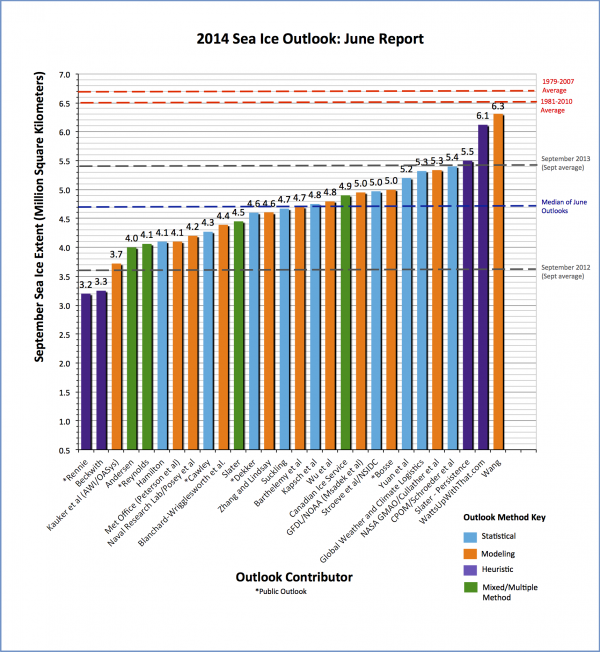More predictions of September Arctic sea ice extent
I published a prediction of Arctic sea ice extent on July 1 that was based on September sea ice extent from 1979 to 2013. That model yielded a prediction that the average extent for September 2014 would be 4.135 million square kilometers. However, that model does not take into consideration any other information we have on Arctic sea ice, such as the ice extent in previous months of the year. It just gives the general trend of sea ice in September from year to year. You cannot use it to predict ice extent based on current ice extent or conditions.
Given that limitation, I decided to build a regression model predicting average extent in September based on the average extents between March and August. I quickly ran into a major problem: colinearity between months. So instead of building one grand model, I was forced to build separate models for each predictor month. Without further ado, here are the top three models based on R2 value:
I also tested models for March, April, and May but found that predictive ability decreased rather dramatically. For instance, the R2 value for the May/September regression was only 0.3878, nearly half of that for June.
So far, the predictions based on June and July ice extents are higher than the one made based on the September trend by itself. The July prediction is very close to the median of the 2014 predictions submitted to the Sea Ice Prediction Network whereas the one made using the September trend alone is trending toward the bottom. I'll update this post with the prediction made using August once August is over.
Update: August ice extent came in at 6.13 million km2. The predicted September extent based on August is 5.23 million km2, the same as the predicted extent based on June. The predicted extent is nearly the same as the extent in September 2013.
Given that limitation, I decided to build a regression model predicting average extent in September based on the average extents between March and August. I quickly ran into a major problem: colinearity between months. So instead of building one grand model, I was forced to build separate models for each predictor month. Without further ado, here are the top three models based on R2 value:
I also tested models for March, April, and May but found that predictive ability decreased rather dramatically. For instance, the R2 value for the May/September regression was only 0.3878, nearly half of that for June.
So far, the predictions based on June and July ice extents are higher than the one made based on the September trend by itself. The July prediction is very close to the median of the 2014 predictions submitted to the Sea Ice Prediction Network whereas the one made using the September trend alone is trending toward the bottom. I'll update this post with the prediction made using August once August is over.
 |
| From the ARCUS website |
Update: August ice extent came in at 6.13 million km2. The predicted September extent based on August is 5.23 million km2, the same as the predicted extent based on June. The predicted extent is nearly the same as the extent in September 2013.







Comments
Post a Comment